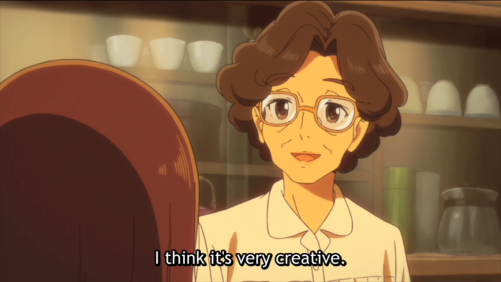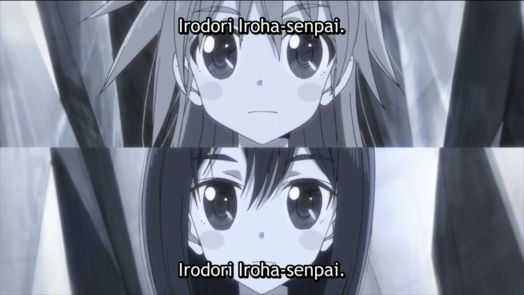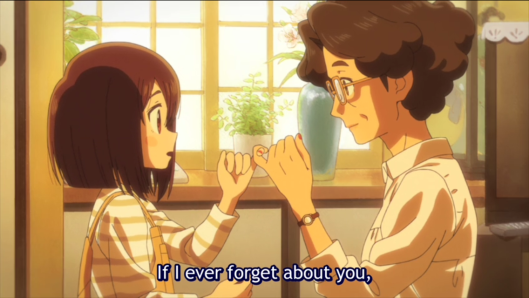Flip Flappers has been confusing since the first episode. Its surreal and abstract storytelling can confuse those of us who think more concretely. Episode 6 was quite the same. However, its underlying message is powerful and so I wanted to explain this episode to those of us who may not have understood who “Iro” was.
*Warning: This post will contain many spoilers!
Who Was Iro?
In Episode 6, Cocona and Papika venture unknowingly into a gateway they find within Pure Illusion. After going through the gate, the girls are transported into an alternate reality where they get separated, both of them becoming little girls. While in this dimension, Cocona and Papika live separate lives and go through different experiences, but both refer to their new selves as “Iro.”
But who exactly was Iro?
I am going to be blunt and say right away that Iro was Irodori Iroha-senpai, the odd artist that Cocona befriends in the first episode. Throughout the first five episodes, this senpai is a side character that Cocona occasionally visits her for tea and a chat.

However, Iroha-senpai becomes a main focal point in Episode 6. In going through the gate in Pure Illusion, Cocona and Papika somehow accessed their senpai’s childhood memories and were living through them.
But Why Were There Two “Iros”?

Although there are two Iros within the memory landscape (an orange one and a blue one), they both represented Iroha-senpai. They symbolize the two lives she was living at the time- a life full of pain and anger, and another life full of hope and encouragement.
Blue Iro
The blue Iro (or Papika for most of the episode) symbolized the life that Iro lived while at home. A miserable life. Iro’s blue complexion, as well as the blue interior of the house, represent the sadness and pain she was going through. Her parents were always fighting and screaming at each other. The atmosphere of the household was extremely negative, and most likely abusive. To break way from this, Iro would lock herself in her home and draw a plethora of pictures.

Iro’s parents who are always fighting.

Blue Iro drawing in her room.
However, her creativity and artistic ability were not encouraged by her parents. They told her that her drawings were strange and that she needed to draw normally.

The negativity and disapproval was too much for Iro to handle- her only means of escape and communication were looked down upon. Because of this, she sought another venue to express herself and found a safe haven in the house of an older woman who had no family or children.
Orange Iro
This is where the orange Iro comes in. She represents the happy life that Iro was living when visiting the older woman, or Auntie (Oba-chan) as Iro calls her. Unlike her parents, the old woman was kind and calm. Her house wasn’t full of yelling or hostility. When she was with Auntie, Iro was happy and carefree. This is not only shown through her smile, but the fact she was in an orange tone- very much like the color of light.

To make Iro even happier, Auntie encouraged Iro to draw and be creative, even though her artwork was a little advant garde.


Auntie gave Iro everything her parents didn’t- love and acceptance- and this is why Iro’s life with her was so drastically different than her life at home.
The Same Person- Becoming One Iro-Chan
Although they are shown as separate, the two Iros were really the same person. While in this reality, the blue Iro only went through the stressful memories of Iroha and the orange Iro lived through the positives ones. However, in real life, Iroha would have been experiencing these events interchangeably- the negatives ones when she was home and the positive ones whenever she got to visit the old woman.When entering this dimension, the two sides of Iro were split into two, but there is actually just one Iro– the poor little girl who had go through all of that suffering.
Cocona and Papika discover this when Auntie gets sick. Near the end of the episode, we learn that Auntie has Alzheimer’s Disease. She cannot remember Iro and doesn’t seem to have any grip on reality. She believes she is still a teacher, even though she retired years ago. When Iro visits Auntie in the hospital and finds out she has been forgotten, her orange tone turns into blue as she realizes her life is going to go back to hell. There is nowhere left for her to escape, no more safe haven. She runs to her house, to the room where blue Iro usually stays and begs with her to switch.

Before the two Iros could switch places because their two realities were so different. But now they are both blue. Their worlds are the same. Two worlds without Auntie equals one world of suffering. Papika understands this and tells Cocona that they are the same person.


They cry together and embrace. Now that they have accepted that they are the same person, together they must confront the problem, a decision that will affect both sides of Iro’s life. Their pain and desire to reconcile with Auntie opens a portal to a new dimension.
This new place is full of gray, and both Iros (now gray themselves) confront Auntie in her hospital bed. The girls have taken on a gray hue because they have resolved to correct their mistake. Right now, they do not know if their decision will lead to more blue or more orange.
When they reach her bed, the old woman asks for the girls’ name and they both answer simultaneously, “Irodori Iroha-senpai.”


When she hears Iro’s full name, Auntie smiles and the beautiful orange light returns.
How Did Their Journey Into Her Childhood Affect Iroha-senpai?
The moment just mentioned reiterates the fact that the two Iro’s represent their senpai as a child. This is also confirmed by other hints in the show, such as when we see Iroha’s name written on a painting that resembles Cocona and Papika’s adventures in Pure Illusion.
But what did all of this have to do with Iroha-senpai, and how does it affect her?
Although we still have a lot to learn in the show, it seems that everything is connected through Pure Illusion and reality, and that the two somehow influence each other. By going into her past, I believe that Cocona and Papika had a small effect on the events of Iroha’s childhood. And here’s why.
Before the Alzheimer’s really set in, Auntie had Iro promise to tell her Iro’s name if she ever forgot it.


At first, Iro (or Cocona) forgets this promise. When Iro finds out that Auntie lost her memory, she runs away crying. It seems that this happened in real life as well. At one point when talking about nail polish, Iroha says, “I don’t paint my nails, though. I don’t have the right to.”Here she is referring to how Auntie gave her nail polish as gift and told her to grow up to be a pretty lady. Based on this, I am assuming that, in real life, she never told Auntie her name, but then remembered the promise when it was too late. She blames herself for not keeping her word and therefore feels as though she shouldn’t wear the nail polish Auntie gave her (or any nail polish) as punishment.


However! As I mentioned, Cocona and Papika tell Auntie Iro’s name and she remembers. Then, when they return to the real world and see Iroha-senpai, she is happily wearing the nail polish Auntie gave her. Could this be a coincidence? It’s possible.
But I don’t think so.
I believe that by going into her childhood memories, Cocona and Papika slightly altered what happened the past and that, in reality, Iroha kept her promise. Now in the present, Iroha no longer feels guilty about wearing the nail polish because there is no reason to. She told Auntie her name, Auntie remembered her, they remained friends, and she cam wear nail polish with no qualms.

Concluding Thoughts
As I said, right now there are still a lot of unanswered questions in this fascinating show. Although we don’t know everything, I think there are enough hints to understand that Pure Illusion and reality definitely effect each other.
To read more theories about Flip Flappers, check out Atlier Emily’s post FLIP FLAPPERS — PURE ILLUSION AND THE PAINTER where she deeply discusses how the “real world” influences Pure Illusion and vice versa; Cauthan Review’s The Colorful Storytelling of ‘Pure Play’ (Spoilers!) where he analyzes the different colors used in depth; and Josei Next Door’s Flip Flappers – Episode 6: “Pure Play”, where she analyzes all of the characters and their growth, including Papika, Cocona, and Iroha.
It may be very confusing on the surface, but I highly recommend this show. It is completely different than any other anime I have seen, and what seems like an insane (and possibly inane) show is actually extremely deep, meaningful, and psychological.

I love how Cocona and Papika as duel representatives of Iro’s psyche have to come together near the end of the episode in order to progress and sort things out. It’s like Iroha has divorced herself from her two identities – unwilling to reconcile that she is both of those personas – both happy and sad. It really supports the theme of maturity and coming to terms with her situation in such a great way.
Thanks for the mention and this was a nice, comprehensive write-up.
LikeLiked by 1 person
I agree completely. The part where the two sides of her subconscious came together was the highlight of the episode. It shows maturity in not only Iroha, but in Papika and Cocona as well. Plus, the creative portrayal of the situation was excellent. You are welcome for the mention, and thank you! 🙂
LikeLiked by 1 person
This was an excellent write-up. I’m all for the theory that Pure Illusion affects the actual world, too. Between your post and the ones you’ve mentioned, I’m starting to realize that Flip Flappers is sticking with a unique form of storytelling that may be hard for people who are used to definite answers in words.
Thank you for sharing.
LikeLiked by 1 person
Thank you! And yes, I am really impressed by the storytelling in the show. It seems like pure insanity on the surface, but it is actually very convoluted and complex. I like being able to ponder all of the different possibilities and theories.
LikeLiked by 1 person